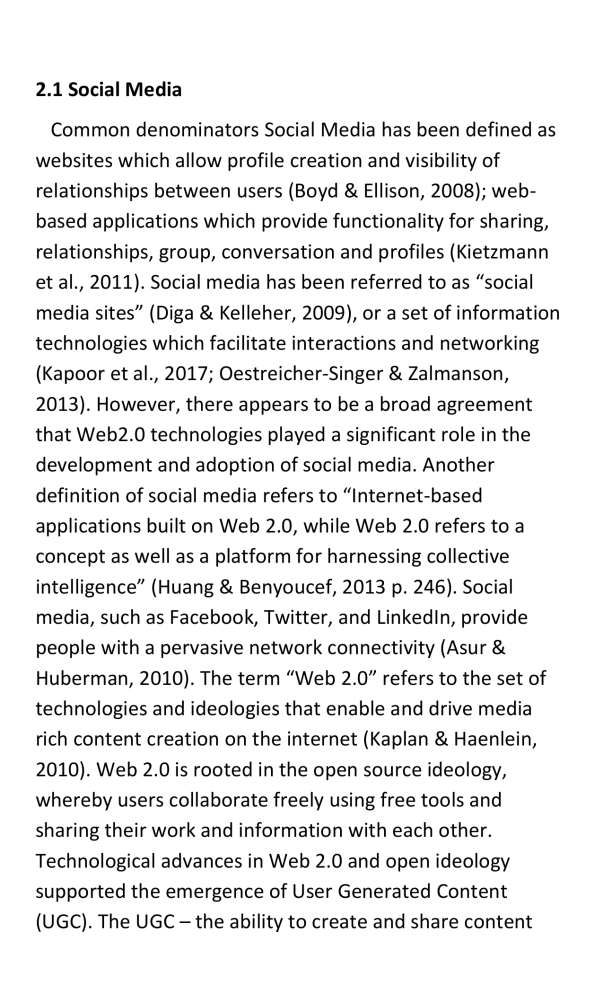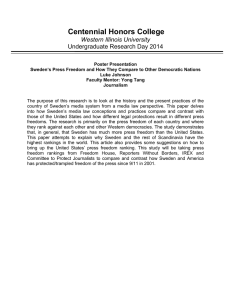
2.1 Social Media Common denominators Social Media has been defined as websites which allow profile creation and visibility of relationships between users (Boyd & Ellison, 2008); webbased applications which provide functionality for sharing, relationships, group, conversation and profiles (Kietzmann et al., 2011). Social media has been referred to as “social media sites” (Diga & Kelleher, 2009), or a set of information technologies which facilitate interactions and networking (Kapoor et al., 2017; Oestreicher-Singer & Zalmanson, 2013). However, there appears to be a broad agreement that Web2.0 technologies played a significant role in the development and adoption of social media. Another definition of social media refers to “Internet-based applications built on Web 2.0, while Web 2.0 refers to a concept as well as a platform for harnessing collective intelligence” (Huang & Benyoucef, 2013 p. 246). Social media, such as Facebook, Twitter, and LinkedIn, provide people with a pervasive network connectivity (Asur & Huberman, 2010). The term “Web 2.0” refers to the set of technologies and ideologies that enable and drive media rich content creation on the internet (Kaplan & Haenlein, 2010). Web 2.0 is rooted in the open source ideology, whereby users collaborate freely using free tools and sharing their work and information with each other. Technological advances in Web 2.0 and open ideology supported the emergence of User Generated Content (UGC). The UGC – the ability to create and share content free of censorship and at low cost, contributed to the proliferation of social media (DesAutels, 2011). As an Information System, social media is built upon a set of (available) Internet, communication and computing technologies, as well as a set of ideological beliefs about how information should be created, accessed and distributed (Figure 1). 1. Social Media Increasing focus on global development and the expansive use of technology in marketing, advertising and promotion have led to shifts in the way in which companies focus on consumers (Quelch & Jocz, 2008). Researchers have recognized that technology has become a major component in expanding markets and have defined entire marketing strategies around global access to technology. At the same time, advertising and promotion often focus on the psychological, emotional, and social factors influencing consumer behaviours, elements that must be incorporated into technologybased marketing (Quelch & Jocz, 2008). As a result, even in the presence of global expansion and new technologies, companies need to look at the four essential “Ps” of marketing: product, price, place, and promotion (Quelch & Jocz, 2008). 2.1.5 The beauty care market in Sweden According to Euromonitor (2010), Cosmetics and Toiletries in Sweden, the data is shown that this market in Sweden had positively expanded years-to-years from the past until 2008. The market continually grows up little by little in slower growth rate. Customers demand becomes seriously aware of price issue. The declining of expensive and luxury products cause retailers to apply ‘price competitive strategy’ - lowering their prices to pull the customers during the economic situation in 2008. Moreover, at the end of the year as a crisis of global finance, Sweden’s central bank (Sveriges Riksbank) swiftly rose the interest rates up in 2007, and also highly expedited in 2008 (Högberg, 2007). Consequently there is higher dept level in Sweden, which affects to customers’ purchasing power. As a result, some brands realized to change to mass positioned brands in the same year, or even private label products. For this market characteristic in Sweden, the market is spitted and primarily led by transnational corporations (TNCs), such as L'Oréal AB, followed by Procter & Gamble Sweden AB and Beiersdorf AB in 2008. Invima AB was the foremost Swedish firm of the top ten ranks that was shown as the ninth rank in 2008 for retail value sales. Major transnational corporations could strengthen its positions de https://www.diva-portal.org/smash/get/diva2:328065/FULLTEXT01. Customer Buying Behavior According to the American Marketing Association, quoted by Kotler & Keller (2006, 6), marketing can be defined as “an organizational function and a set of processes for creating, communicating, and delivering value to customers and for managing customer relationships in ways that benefit the organization and its stakeholders”. In other words, marketing in a simplified meaning indicates that the product or service being marketed should meet the customers demand, needs and values. Furthermore, another simpler definition is presented as marketing “includes anticipating demand, managing demand, and satisfying demand” (Evans & Berman 1997, 7). Marketing could also be defined in a few words with “mutually satisfying exchange relationships” (Baker 2006, 4-5). At times it can be difficult to determine the actual difference between marketing and sales, therefore Fifield (2006, 1) has defined the two as sales being “about ensuring the customer buys what the company makes” and marketing being “about ensuring that the company makes what the customer wants to buy”. https://www.theseus.fi/bitstream/handle/10024/3843/BBA_Thesis_Weckman.pdf?sequence= 1&isAllowed=y


